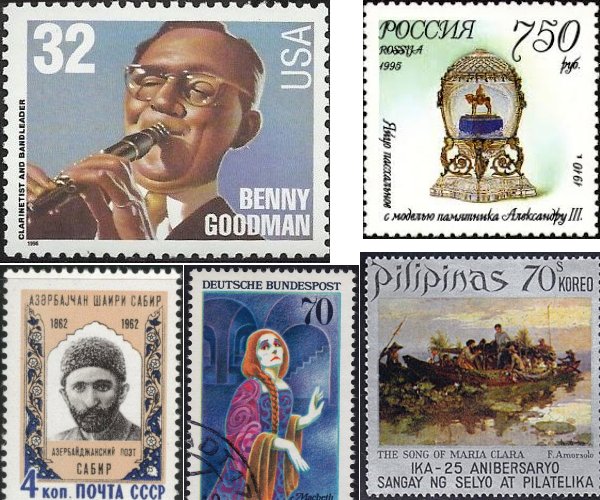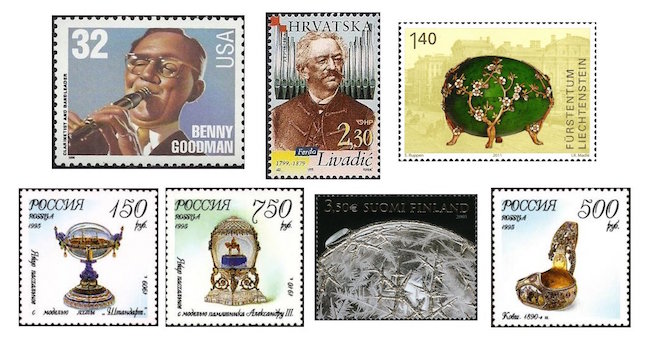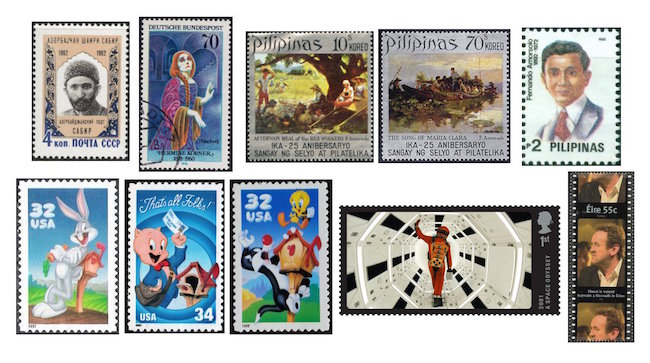The Arts on the Stamps of the World — May 30
An Arts Fuse regular feature: the arts on stamps of the world.

By Doug Briscoe
Benny Goodman (May 30, 1909 – June 13, 1986), although best known as a jazz and swing bandleader and clarinetist, was also keenly interested in classical music. He commissioned Copland’s Clarinet Concerto and Bartók’s Contrasts for clarinet, violin, and piano, and was the dedicatee of Malcolm Arnold’s Clarinet Concerto no. 2. He made recordings of a number of classical works, including the Mozart Concerto and Quintet, which he recorded in 1956 with members of the BSO. (He made an earlier recording of the Quintet in 1938.)
Ferdo Livadić (lih-VAH-ditch), aka Ferdinand Wiesner (30 May 1799 – 8 January 1879), was a Croatian composer who wrote three masses, numerous art songs in Croatian, Slovenian, and German, and short piano pieces.
Peter Carl (or Karl Gustavovich) Fabergé (30 May 1846 – 24 September 1920), a descendant of Huguenots, was born in Saint Petersburg, Russia. His father Gustave, who came from German Livonia, established a jewelry business in Russia in 1842, and Peter Carl took over in 1860 when Gustave retired. Leaving the company in the hands of his father’s foreman, Peter embarked on a tour of Europe with an eye to learning more of the goldsmith’s art. The first Fabergé egg was made in 1885 as an Easter gift for Tsar Alexander III to give to his wife Maria Fyodorovna. It was the first of some fifty eggs made for the royal house, thirty for Maria Fyodorovna and a further twenty for Nicholas II’s wife Alexandra. Fifteen more were made for other clients. One of these is the 1901 Apple Blossom Egg, made for the industrialist Alexander Kelch and seen on a stamp from Liechtenstein. The others we see are all royal eggs: on the Russian stamps we have the Standart Yacht of 1909 and the Alexander III Equestrian of 1910. On the Finnish stamp is the Winter Egg of 1913. Of course, the house of Fabergé made many other items, such as the 1890 ladle seen at right.
Mirza Alakbar Sabir (30 May 1862 – 12 July 1911) was a satirical poet from Azerbaijan. As a youth he translated Persian poetry and wrote his own poems in Azeri. Deeply affected by the Russian Revolution of 1905, Sabir began to take aim at Tsarist and clerical injustices, the follies of landowners, and the oppression of women and the poor. Winning popularity among the people, of course, earned him the scrutiny of the authorities. Persecution and poverty weakened his health, and he died of liver disease at 49.

The German actress and theater director Hermine Körner (née Stader, 30 May 1878 – 14 December 1960) was born in Berlin to a zoologist father whom she hardly knew, as he went to the United States on a lecture tour when she was two and remained there until he died eight years later. Apparently the family was not left destitute, as Hermine was able to take piano lessons with Max Reger. After her marriage in 1897 she made her stage debut in Vienna, later working in Düsseldorf (under Louise Dumont), Dresden, her native Berlin, under Max Reinhardt, and other German cities. She began working in silent films in 1916 and made periodic appearances on the screen for the next forty years, right up to her death at age 82. Her friend the actress Emmy Sonnemann became Hermann Göring’s second wife.
Filipino painter Fernando Amorsolo y Cueto (May 30, 1892 – April 24, 1972) is considered to be one of the important artists from his country. When he was thirteen Amorsolo became apprenticed to his mother’s cousin the painter Fabián de la Rosa. Later Amorsolo went to a Manila art school and the University of the Philippines’ College of Fine Arts, which he directed from 1938 to 1952. Amorsolo created landscapes, portraits, and genre paintings, mostly bright and optimistic works, the exceptions being the somber pieces he did during the Japanese occupation. The Filipino stamps show his Afternoon Meal of the Rice Workers and Song of Maria Clara as well as honoring the artist himself. While researching this piece I came across his very fetching Fruit Pickers Under the Mango Tree.

It’s hardly surprising that Melvin Jerome “Mel” Blanc (May 30, 1908 – July 10, 1989) got his start in radio. He started providing voices for cartoons in 1937. Instead of a raise, Blanc once agreed to a screen credit, making him the first voice actor to be thus recognized. Although there is no stamp for the man behind the voice, there are a few for the cartoons with which the voice is inextricably linked: three stamps for four of his best known characters.
Two screen actors known for their work in sci-fi share this birthday: Keir Dullea (born May 30, 1936), who played astronaut Dave Bowman in 2001: A Space Odyssey (making his way through the Discovery One airlock on the British stamp), and Colm Meaney (Colm Ó Maonaigh; born 30 May 1953), probably best known to American audiences as transporter chief Miles O’Brien on the Star Trek spinoffs The Next Generation and Deep Space Nine. On the stamp from his native Ireland, however, he is seen in a still from the 2007 film Kings.
While we’re on the subject of the movies, it’s the birthday of American director Howard Hawks (May 30, 1896 – December 26, 1977), not seen on any stamp that I know of.
A graduate of the University of Massachusetts with a B.A. in English, Doug Briscoe worked in Boston classical music radio, at WCRB, WGBH, and WBUR, for about 25 years, beginning in 1977. He has the curious distinction of having succeeded Robert J. Lurtsema twice, first as host of WGBH’s weekday morning classical music program in 1993, then as host of the weekend program when Robert J.’s health failed in 2000. Doug also wrote liner notes for several of the late Gunther Schuller’s GM Recordings releases as well as program notes for the Boston Classical Orchestra. For the past few years he’s been posting a Facebook “blog” of classical music on stamps of the world, which has now been expanded to encompass all the arts for The Arts Fuse.
